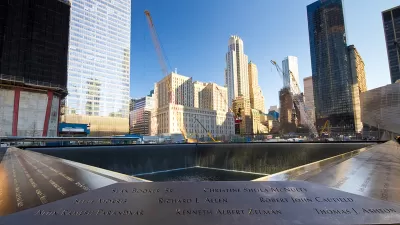The grand opening of the 9/11 memorial and museum is derided by critics as a cold, uninviting public space, and 'ritualizing grief on a loop'

On May 15, 2014 President Obama gave solemn remarks of remembrance for the families lost and reminded all once again of the terrible tragedies that opened a national, even international, wound.
New York Times architecture critic Michel Kimmelman reviews the newly dedicated museum, offering reverence amidst reproach for the entire memorial and museum. Kimmelman, who has visited the site at multiple times of the day on several occasions since its opening, agrees with the site as one of poignant national nostalgia: "This is a place for remembrance, but it’s not like [other national memorials in DC]. The site of the Sept. 11 memorial is not singularly devoted to those who died. It also serves as the forecourt for an office development and as public space for Lower Manhattan. The neighborhood was a casualty, too, along with the rest of New York."
The primary issue, joined by several commentaries authored on the space including The Washington Post's Philip Kennicott, insists that the design incites fear and evokes dread rather than engages and enlivens. Kennicott scathes the entire project, saying the designs "subsume educational material in an emotional narrative, punctuated by over-scaled, emotionally fraught objects, amplified by every architectural, cinematic, literary and religious tool available."
"The place doesn’t feel like New York. It feels like a swath of the National Mall plunked in downtown Manhattan: formal, gigantic, impersonal, flat, built to awe, something for tourists," Kimmelman asserts in his piece, discussing minute details and calling out a flawed design process hijacked by politics. "I admire Snohetta. Not this building, though: from the outside, a mirrored glass-and-steel jumble of tilting planes with a trapezoid roof, poorly detailed, presenting a cold face to the south fountain…The place doesn’t do much to celebrate the city’s values of energy, diversity, tolerance openness and debate." Kimmelman furthermore extolls the public seating as 'severe' and laments the landscaping, which 'thwarts the natural flow of pedestrian traffic.'
Is the national space created to memorialize the day that changed everything for many of our readers a designed dead space?
FULL STORY: Finding Space for the Living at a Memorial

Maui's Vacation Rental Debate Turns Ugly
Verbal attacks, misinformation campaigns and fistfights plague a high-stakes debate to convert thousands of vacation rentals into long-term housing.

Planetizen Federal Action Tracker
A weekly monitor of how Trump’s orders and actions are impacting planners and planning in America.

In Urban Planning, AI Prompting Could be the New Design Thinking
Creativity has long been key to great urban design. What if we see AI as our new creative partner?

King County Supportive Housing Program Offers Hope for Unhoused Residents
The county is taking a ‘Housing First’ approach that prioritizes getting people into housing, then offering wraparound supportive services.

Researchers Use AI to Get Clearer Picture of US Housing
Analysts are using artificial intelligence to supercharge their research by allowing them to comb through data faster. Though these AI tools can be error prone, they save time and housing researchers are optimistic about the future.

Making Shared Micromobility More Inclusive
Cities and shared mobility system operators can do more to include people with disabilities in planning and operations, per a new report.
Urban Design for Planners 1: Software Tools
This six-course series explores essential urban design concepts using open source software and equips planners with the tools they need to participate fully in the urban design process.
Planning for Universal Design
Learn the tools for implementing Universal Design in planning regulations.
planning NEXT
Appalachian Highlands Housing Partners
Mpact (founded as Rail~Volution)
City of Camden Redevelopment Agency
City of Astoria
City of Portland
City of Laramie



























